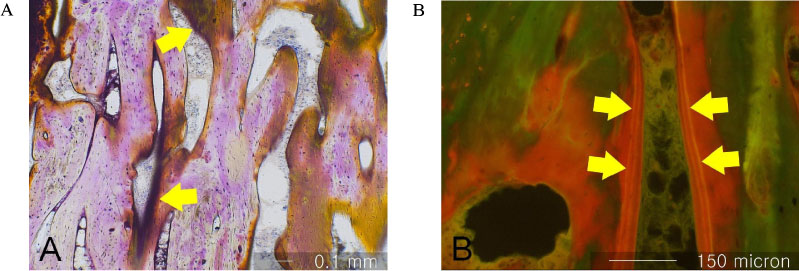J Korean Endocr Soc.
2006 Dec;21(6):583-588.
A Case of Familial Hypocalciuric Hypercalcemia Coexisting with Low Bone Mass
- Affiliations
-
- 1Department of Internal Medicine Yonsei University College of Medicine, Korea.
- 2Department of Oral Pathology Yonsei University College of Dentistry, Korea.
- 3Department of Endocrinology and Metabolism, Ajou University School of Medicine, Korea.
Abstract
- Familial hypocalciuric hypercalcemia is caused by heterozygous loss-of-function mutation of the calcium sensing receptor gene, and this is characterized by mild, persistently elevated levels of serum calcium without symptoms or complications. We present a case of clinically diagnosed familial hypocalciuric hypercalcemia with unexpected low bone mass. A 19-year-old man presented with incidentally discovered hypercalcemia. He showed normal growth and sexual maturation. Biochemical studies showed hypercalcemia, increased parathyroid hormone, hypocalciuria, a decreased urinary calcium-creatinine ratio and decreased serum 25-hydroxy-vitamin D. The other hormonal studies were normal. Dual energy x-ray absorptiometry showed low bone mineral density, and the Sestamibi scan showed no abnormality in the parathyroid glands. Iliac bone biopsy showed a general decrease in bone density and increased porosity of the cortical bone. Normal mineralization was also shown, but in part, osteoid deposition was also found. Direct sequencing of the patient's calcium sensing receptor gene showed a point mutation at exon7, Q926R.
MeSH Terms
Figure
Reference
-
1. Gunn IR, Gaffney D. Clinical and laboratory features of calcium sensing receptor disorders: a systemic review. Ann Clin Biochem. 2004. 41:441–458.2. Chou YH, Brown EM, Levi T, Crowe G, Atkinson AB, Arnqvist HJ. The gene responsible for familial hypocalciuric hypercalcemia maps to chromosome 3q in four unrelated families. Nat Genet. 1992. 1:295–300.3. Pollak MR, Brown EM, Chou YH, Hebert SC, Marx SJ, Steinmann B. Mutations in the human Ca(2+)-sensing receptor gene cause familial hypocalciuric hypercalcemia and neonatal severe hyperparathyroidism. Cell. 1993. 75:1297–1303.4. Pidasheva S, D'Souza-Li L, Canaff L, Cole DE, Hendy GN. Calcium-sensing receptor locus-specific database for mutations causing familial (benign) hypocalciuric hypercalcemia, neonatal severe hyperparathyroidism, and autosomal dominant hypocalcemia. Hum Mutat. 2004. 24:107–111.5. Woo SI, Song HS, Song KE, Kim DJ, Lee KW, Kim SJ, Chung YS. A case report of familial benign hypocalciuric hypercalcemia: a mutation in the calcium-sensing receptor gene. Yonsei Med J. 2006. 47:255–258.6. Felderbauer P, Hoffmann P, Klein W, Bulut K, Ansorge N, Epplen JT, Schmitz F, Schmidt WE. Identification of a novel calcium-sensing receptor gene mutation causing familial hypocalciuric hypercalcemia by single strand conformational polymorphism analysis. Exp Clin Endocrinol Diabetes. 2005. 113:31–34.7. Brown EM, MacLeod RJ. Extracellular calcium sensing and extracellular calcium signaling. Physiol Rev. 2001. 81:239–297.8. Pollak MR, Brown EM, Estep HL, McLaine PN, Kifor O, Park J, Hebert SC, Seidman CE, Seidman JG. Autosomal dominant hypocalcaemia caused by Ca(2+)-sensing receptor gene mutation. Nat Genet. 1994. 8:303–307.9. Pearce SH, Williamson C, Kifor O, Bai M, Coulthard MG, Davies M, Lewis-Barned N, McCredie D, Powell H, Kendall-Taylor P, Brown EM, Thakker RV. A familial syndrome of hypocalcemia with hypercalciuria due to mutations in the calcium-sensing receptor. N Engl J Med. 1996. 335:1115–1122.10. Kozue M, Ilda K, Thais DM, Hamilton C, Durval D, Nuvarte S, Omar HM. Severe hypercalcemia in a 9-year old Brazilian girl due to a novel inactivating mutation of the calcium sensing receptor. J Clin Endocrinol Metab. 2004. 89:5936–5941.11. Law WM Jr, Heath H III. Familial benign hypercalcemia (hypocalciuric hypercalcemia) clinical and pathogenetic studies in 21 families. Ann Intern Med. 1985. 102:511–519.12. Aurbach GD, Marx SJ, Spiegel AM. Wilson JD, Foster DW, editors. Parathyroid hormone, calcitonin, and the calciferols. Textbook of Endocrinology. 1985. 7th ed. Philadelphia: WB Saunders;1137.13. Heath DA. Bilezikian JP, Marcus R, Levine MA, editors. Familial hypocalciuric hypercalcemia. The Parathyroid: basic and clinical concepts. 1994. New York: Raven Press;699.14. Kristiansen JH, Rodbro P, Christiansen C, Johansen J, Jensen JT. Familial hypocalciuric hypercalcemia III: bone mineral metabolism. Clin Endocrinol. 1987. 26:713–716.15. Cynthia TM, Francine WS, Benise AW, William AM, David BK, Steven LT, Reta CR, Michael PW. Significant developmental elevation in serum parathyroid hormone levels in a large kindred with familial benign (hypocalciuric) hypercalcemia. Am J Med. 1992. 93:247–258.16. Haag C, Schulze E, Lorenz A, Frank-Raue1 K, Raue F. Novel mutations of the calcium sensing receptor in patients with familial hypocalciuric hypercalcemia and autosomal dominant hypocalcemia. European calcified tissue society. 2005. http://www.ectsoc.org.17. Arab L, Carriquiry A, Steck-Scott S, Gaudet MM. Ethnic differences in nutrient intake adequacy of premenopausal US women: result from the Third National Health and Nutrition Examination Survey. J Am Diet Assoc. 2003. 103:1008–1014.18. Carolyn M, Mary MM, Debra RK, Michael FH. Vitamin D intake in the United States. J Am Diet Assoc. 2004. 104:980–983.19. Kazutoshi N, Mitsue N, Shigeki M, Masaharu Y. Low serum concentrations of 25-hydroxyvitamin D in young adult Japanese women: a cross sectional study. Nutrition. 2001. 17:921–925.
- Full Text Links
- Actions
-
Cited
- CITED
-
- Close
- Share
- Similar articles
-
- A Case Report of Familial Benign Hypocalciuric Hypercalcemia: A Mutation in the Calcium-Sensing Receptor Gene
- A Case of Familial Hypocalciuric Hypercalcemia Coexisting with Hypothyroidism
- Primary hyperparathyroidism versus familial hypocalciuric hypercalcemia: a challenging diagnostic evaluation in an adolescent female
- A Case of Severe Hypercalcemia after Treatment with Teriparatide for Osteoporosis
- A case of parathyroid carcinoma with meningioma





